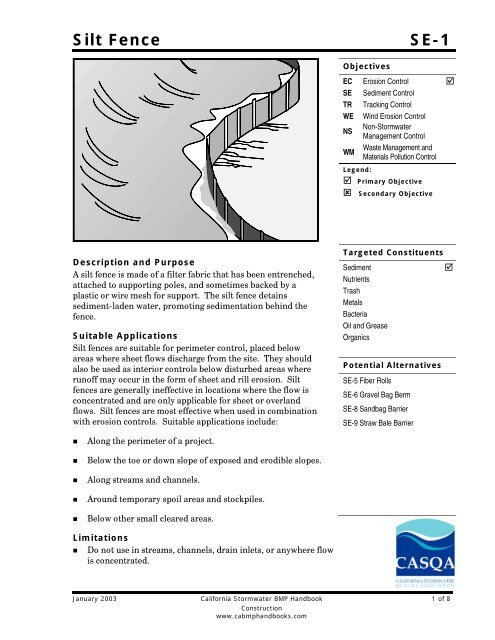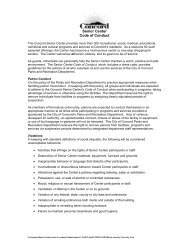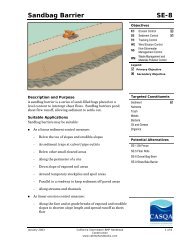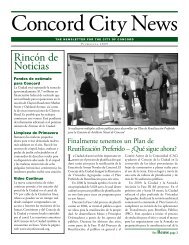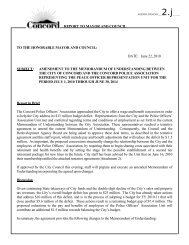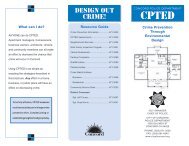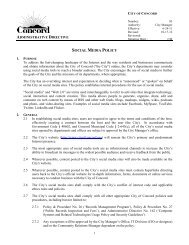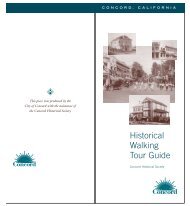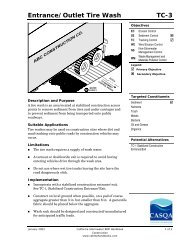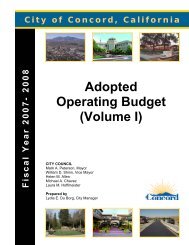Silt Fence SE-1 - State Water Resources Control Board - State of ...
Silt Fence SE-1 - State Water Resources Control Board - State of ...
Silt Fence SE-1 - State Water Resources Control Board - State of ...
You also want an ePaper? Increase the reach of your titles
YUMPU automatically turns print PDFs into web optimized ePapers that Google loves.
<strong>Silt</strong> <strong>Fence</strong><br />
<strong>SE</strong>-1<br />
Objectives<br />
EC Erosion <strong>Control</strong> <br />
<strong>SE</strong> Sediment <strong>Control</strong><br />
TR Tracking <strong>Control</strong><br />
WE Wind Erosion <strong>Control</strong><br />
Non-Stormwater<br />
NS<br />
Management <strong>Control</strong><br />
Waste Management and<br />
WM<br />
Materials Pollution <strong>Control</strong><br />
Legend:<br />
Primary Objective<br />
Secondary Objective<br />
Description and Purpose<br />
A silt fence is made <strong>of</strong> a filter fabric that has been entrenched,<br />
attached to supporting poles, and sometimes backed by a<br />
plastic or wire mesh for support. The silt fence detains<br />
sediment-laden water, promoting sedimentation behind the<br />
fence.<br />
Suitable Applications<br />
<strong>Silt</strong> fences are suitable for perimeter control, placed below<br />
areas where sheet flows discharge from the site. They should<br />
also be used as interior controls below disturbed areas where<br />
run<strong>of</strong>f may occur in the form <strong>of</strong> sheet and rill erosion. <strong>Silt</strong><br />
fences are generally ineffective in locations where the flow is<br />
concentrated and are only applicable for sheet or overland<br />
flows. <strong>Silt</strong> fences are most effective when used in combination<br />
with erosion controls. Suitable applications include:<br />
Targeted Constituents<br />
Sediment<br />
Nutrients<br />
Trash<br />
Metals<br />
Bacteria<br />
Oil and Grease<br />
Organics<br />
Potential Alternatives<br />
<strong>SE</strong>-5 Fiber Rolls<br />
<strong>SE</strong>-6 Gravel Bag Berm<br />
<strong>SE</strong>-8 Sandbag Barrier<br />
<strong>SE</strong>-9 Straw Bale Barrier<br />
<br />
• Along the perimeter <strong>of</strong> a project.<br />
• Below the toe or down slope <strong>of</strong> exposed and erodible slopes.<br />
• Along streams and channels.<br />
• Around temporary spoil areas and stockpiles.<br />
• Below other small cleared areas.<br />
Limitations<br />
• Do not use in streams, channels, drain inlets, or anywhere flow<br />
is concentrated.<br />
January 2003 California Stormwater BMP Handbook 1 <strong>of</strong> 8<br />
Construction<br />
www.cabmphandbooks.com
<strong>SE</strong>-1<br />
<strong>Silt</strong> <strong>Fence</strong><br />
• Do not use in locations where ponded water may cause flooding.<br />
• Do not place fence on a slope, or across any contour line. If not installed at the same<br />
elevation throughout, silt fences will create erosion.<br />
• Filter fences will create a temporary sedimentation pond on the upstream side <strong>of</strong> the fence<br />
and may cause temporary flooding. <strong>Fence</strong>s not constructed on a level contour will be<br />
overtopped by concentrated flow resulting in failure <strong>of</strong> the filter fence.<br />
• Improperly installed fences are subject to failure from undercutting, overlapping, or<br />
collapsing.<br />
- Not effective unless trenched and keyed in.<br />
- Not intended for use as mid-slope protection on slopes greater than 4:1 (H:V).<br />
- Do not allow water depth to exceed 1.5 ft at any point.<br />
Implementation<br />
General<br />
A silt fence is a temporary sediment barrier consisting <strong>of</strong> filter fabric stretched across and<br />
attached to supporting posts, entrenched, and, depending upon the strength <strong>of</strong> fabric used,<br />
supported with plastic or wire mesh fence. <strong>Silt</strong> fences trap sediment by intercepting and<br />
detaining small amounts <strong>of</strong> sediment-laden run<strong>of</strong>f from disturbed areas in order to promote<br />
sedimentation behind the fence.<br />
<strong>Silt</strong> fences are preferable to straw bale barriers in many cases. Laboratory work at the Virginia<br />
Highway and Transportation Research Council has shown that silt fences can trap a much<br />
higher percentage <strong>of</strong> suspended sediments than can straw bales. While the failure rate <strong>of</strong> silt<br />
fences is lower than that <strong>of</strong> straw bale barriers, there are many instances where silt fences have<br />
been improperly installed. The following layout and installation guidance can improve<br />
performance and should be followed:<br />
• Use principally in areas where sheet flow occurs.<br />
• Don't use in streams, channels, or anywhere flow is concentrated. Don’t use silt fences to<br />
divert flow.<br />
• Don't use below slopes subject to creep, slumping, or landslides.<br />
• Select filter fabric that retains 85% <strong>of</strong> soil by weight, based on sieve analysis, but that is not<br />
finer than an equivalent opening size <strong>of</strong> 70.<br />
• Install along a level contour, so water does not pond more than 1.5 ft at any point along the<br />
silt fence.<br />
• The maximum length <strong>of</strong> slope draining to any point along the silt fence should be 200 ft or<br />
less.<br />
• The maximum slope perpendicular to the fence line should be 1:1.<br />
2 <strong>of</strong> 8 California Stormwater BMP Handbook January 2003<br />
Construction<br />
www.cabmphandbooks.com
<strong>Silt</strong> <strong>Fence</strong><br />
<strong>SE</strong>-1<br />
• Provide sufficient room for run<strong>of</strong>f to pond behind the fence and to allow sediment removal<br />
equipment to pass between the silt fence and toes <strong>of</strong> slopes or other obstructions. About<br />
1200 ft 2 <strong>of</strong> ponding area should be provided for every acre draining to the fence.<br />
• Turn the ends <strong>of</strong> the filter fence uphill to prevent stormwater from flowing around the fence.<br />
• Leave an undisturbed or stabilized area immediately down slope from the fence where<br />
feasible.<br />
• <strong>Silt</strong> fences should remain in place until the disturbed area is permanently stabilized.<br />
Design and Layout<br />
Selection <strong>of</strong> a filter fabric is based on soil conditions at the construction site (which affect the<br />
equivalent opening size (EOS) fabric specification) and characteristics <strong>of</strong> the support fence<br />
(which affect the choice <strong>of</strong> tensile strength). The designer should specify a filter fabric that<br />
retains the soil found on the construction site yet that it has openings large enough to permit<br />
drainage and prevent clogging. The following criteria is recommended for selection <strong>of</strong> the<br />
equivalent opening size:<br />
1. If 50 percent or less <strong>of</strong> the soil, by weight, will pass the U.S. Standard Sieve No. 200,<br />
select the EOS to retain 85 % <strong>of</strong> the soil. The EOS should not be finer than EOS 70.<br />
2. For all other soil types, the EOS should be no larger than the openings in the U.S.<br />
Standard Sieve No. 70 except where direct discharge to a stream, lake, or wetland<br />
will occur, then the EOS should be no larger than Standard Sieve No. 100.<br />
To reduce the chance <strong>of</strong> clogging, it is preferable to specify a fabric with openings as large as<br />
allowed by the criteria. No fabric should be specified with an EOS smaller than U.S. Standard<br />
Sieve No. 100. If 85% or more <strong>of</strong> a soil, by weight, passes through the openings in a No. 200<br />
sieve, filter fabric should not be used. Most <strong>of</strong> the particles in such a soil would not be retained<br />
if the EOS was too large and they would clog the fabric quickly if the EOS were small enough to<br />
capture the soil.<br />
The fence should be supported by a plastic or wire mesh if the fabric selected does not have<br />
sufficient strength and bursting strength characteristics for the planned application (as<br />
recommended by the fabric manufacturer). Filter fabric material should contain ultraviolet<br />
inhibitors and stabilizers to provide a minimum <strong>of</strong> six months <strong>of</strong> expected usable construction<br />
life at a temperature range <strong>of</strong> 0 °F to 120 °F.<br />
• Layout in accordance with attached figures.<br />
• For slopes steeper than 2:1 (H:V) and that contain a high number <strong>of</strong> rocks or large dirt clods<br />
that tend to dislodge, it may be necessary to install additional protection immediately<br />
adjacent to the bottom <strong>of</strong> the slope, prior to installing silt fence. Additional protection may<br />
be a chain link fence or a cable fence.<br />
• For slopes adjacent to sensitive receiving waters or Environmentally Sensitive Areas (ESAs),<br />
silt fence should be used in conjunction with erosion control BMPs.<br />
January 2003 California Stormwater BMP Handbook 3 <strong>of</strong> 8<br />
Construction<br />
www.cabmphandbooks.com
<strong>SE</strong>-1<br />
<strong>Silt</strong> <strong>Fence</strong><br />
Materials<br />
• <strong>Silt</strong> fence fabric should be woven polypropylene with a minimum width <strong>of</strong> 36 in. and a<br />
minimum tensile strength <strong>of</strong> 100 lb force. The fabric should conform to the requirements in<br />
ASTM designation D4632 and should have an integral reinforcement layer. The<br />
reinforcement layer should be a polypropylene, or equivalent, net provided by the<br />
manufacturer. The permittivity <strong>of</strong> the fabric should be between 0.1 sec -1 and 0.15 sec -1 in<br />
conformance with the requirements in ASTM designation D4491.<br />
• Wood stakes should be commercial quality lumber <strong>of</strong> the size and shape shown on the plans.<br />
Each stake should be free from decay, splits or cracks longer than the thickness <strong>of</strong> the stake<br />
or other defects that would weaken the stakes and cause the stakes to be structurally<br />
unsuitable.<br />
• Staples used to fasten the fence fabric to the stakes should be not less than 1.75 in. long and<br />
should be fabricated from 15 gauge or heavier wire. The wire used to fasten the tops <strong>of</strong> the<br />
stakes together when joining two sections <strong>of</strong> fence should be 9 gauge or heavier wire.<br />
Galvanizing <strong>of</strong> the fastening wire will not be required.<br />
• There are new products that may use prefabricated plastic holders for the silt fence and use<br />
bar reinforcement instead <strong>of</strong> wood stakes. If bar reinforcement is used in lieu <strong>of</strong> wood<br />
stakes, use number four or greater bar. Provide end protection for any exposed bar<br />
reinforcement.<br />
Installation Guidelines<br />
<strong>Silt</strong> fences are to be constructed on a level contour. Sufficient area should exist behind the fence<br />
for ponding to occur without flooding or overtopping the fence.<br />
• A trench should be excavated approximately 6 in. wide and 6 in. deep along the line the<br />
proposed silt fence.<br />
• Bottom <strong>of</strong> the silt fence should be keyed-in a minimum <strong>of</strong> 12 in.<br />
• Posts should be spaced a maximum <strong>of</strong> 6 ft apart and driven securely into the ground a<br />
minimum <strong>of</strong> 18 in. or 12 in. below the bottom <strong>of</strong> the trench.<br />
• When standard strength filter fabric is used, a plastic or wire mesh support fence should be<br />
fastened securely to the upslope side <strong>of</strong> posts using heavy–duty wire staples at least 1 in.<br />
long. The mesh should extend into the trench. When extra-strength filter fabric and closer<br />
post spacing are used, the mesh support fence may be eliminated. Filter fabric should be<br />
purchased in a long roll, then cut to the length <strong>of</strong> the barrier. When joints are necessary,<br />
filter cloth should be spliced together only at a support post, with a minimum 6 in. overlap<br />
and both ends securely fastened to the post.<br />
• The trench should be backfilled with compacted native material.<br />
• Construct silt fences with a setback <strong>of</strong> at least 3 ft from the toe <strong>of</strong> a slope. Where a silt fence<br />
is determined to be not practicable due to specific site conditions, the silt fence may be<br />
constructed at the toe <strong>of</strong> the slope, but should be constructed as far from the toe <strong>of</strong> the slope<br />
as practicable. <strong>Silt</strong> fences close to the toe <strong>of</strong> the slope will be less effective and difficult to<br />
maintain.<br />
4 <strong>of</strong> 8 California Stormwater BMP Handbook January 2003<br />
Construction<br />
www.cabmphandbooks.com
<strong>Silt</strong> <strong>Fence</strong><br />
<strong>SE</strong>-1<br />
• Construct the length <strong>of</strong> each reach so that the change in base elevation along the reach does<br />
not exceed 1/3 the height <strong>of</strong> the barrier; in no case should the reach exceed 500 ft.<br />
Costs<br />
• Average annual cost for installation and maintenance (assumes 6 month useful life): $7 per<br />
lineal foot ($850 per drainage acre). Range <strong>of</strong> cost is $3.50 - $9.10 per lineal foot.<br />
Inspection and Maintenance<br />
• Inspect BMPs prior to forecast rain, daily during extended rain events, after rain events,<br />
weekly during the rainy season, and at two-week intervals during the non-rainy season.<br />
• Repair undercut silt fences.<br />
• Repair or replace split, torn, slumping, or weathered fabric. The lifespan <strong>of</strong> silt fence fabric<br />
is generally 5 to 8 months.<br />
• <strong>Silt</strong> fences that are damaged and become unsuitable for the intended purpose should be<br />
removed from the site <strong>of</strong> work, disposed <strong>of</strong>, and replaced with new silt fence barriers.<br />
• Sediment that accumulates in the BMP must be periodically removed in order to maintain<br />
BMP effectiveness. Sediment should be removed when the sediment accumulation reaches<br />
one-third <strong>of</strong> the barrier height. Sediment removed during maintenance may be incorporated<br />
into earthwork on the site or disposed at an appropriate location.<br />
• <strong>Silt</strong> fences should be left in place until the upstream area is permanently stabilized. Until<br />
then, the silt fence must be inspected and maintained.<br />
• Holes, depressions, or other ground disturbance caused by the removal <strong>of</strong> the silt fences<br />
should be backfilled and repaired.<br />
References<br />
Manual <strong>of</strong> Standards <strong>of</strong> Erosion and Sediment <strong>Control</strong> Measures, Association <strong>of</strong> Bay Area<br />
Governments, May 1995.<br />
National Management Measures to <strong>Control</strong> Nonpoint Source Pollution from Urban Areas,<br />
United <strong>State</strong>s Environmental Protection Agency, 2002.<br />
Proposed Guidance Specifying Management Measures for Sources <strong>of</strong> Nonpoint Pollution in<br />
Coastal <strong>Water</strong>s, Work Group-Working Paper, U<strong>SE</strong>PA, April 1992.<br />
Sedimentation and Erosion <strong>Control</strong> Practices, and Inventory <strong>of</strong> Current Practices (Draft),<br />
UESPA, 1990.<br />
Southeastern Wisconsin Regional Planning Commission (SWRPC). Costs <strong>of</strong> Urban Nonpoint<br />
Source <strong>Water</strong> Pollution <strong>Control</strong> Measures. Technical Report No. 31. Southeastern Wisconsin<br />
Regional Planning Commission, Waukesha, WI. 1991<br />
Stormwater Quality Handbooks - Construction Site Best Management Practices (BMPs) Manual,<br />
<strong>State</strong> <strong>of</strong> California Department <strong>of</strong> Transportation (Caltrans), November 2000.<br />
January 2003 California Stormwater BMP Handbook 5 <strong>of</strong> 8<br />
Construction<br />
www.cabmphandbooks.com
<strong>SE</strong>-1<br />
<strong>Silt</strong> <strong>Fence</strong><br />
Stormwater Management Manual for The Puget Sound Basin, Washington <strong>State</strong> Department <strong>of</strong><br />
Ecology, Public Review Draft, 1991.<br />
U.S. Environmental Protection Agency (U<strong>SE</strong>PA). Stormwater Management for Industrial<br />
Activities: Developing Pollution Prevention Plans and Best Management Practices. U.S.<br />
Environmental Protection Agency, Office <strong>of</strong> <strong>Water</strong>, Washington, DC, 1992.<br />
<strong>Water</strong> Quality Management Plan for the Lake Tahoe Region, Volume II, Handbook <strong>of</strong><br />
Management Practices, Tahoe Regional Planning Agency, November 1988.<br />
6 <strong>of</strong> 8 California Stormwater BMP Handbook January 2003<br />
Construction<br />
www.cabmphandbooks.com
<strong>Silt</strong> <strong>Fence</strong><br />
<strong>SE</strong>-1<br />
January 2003 California Stormwater BMP Handbook 7 <strong>of</strong> 8<br />
Construction<br />
www.cabmphandbooks.com
<strong>SE</strong>-1<br />
<strong>Silt</strong> <strong>Fence</strong><br />
8 <strong>of</strong> 8 California Stormwater BMP Handbook January 2003<br />
Construction<br />
www.cabmphandbooks.com


